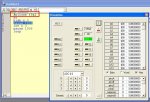BillyGreen1973
Senior Member
Today I updated to 5.3.5 to try the axe401 simulation.
I used the code sample given in the axe401.pdf i.e.
It runs fine, however when I tried to run the same code without the '#Sim Shield' directive, and changing the pin number S.13 to c.3, it still simulated as the shield base.
So I then tried changing the #picaxe directive to 18m2, this runs fine. I chnged it back to #picaxe 28x2 (#sim shield line still not there) it simuates as the shield base again.
I tried 40x2 as the #picaxe directive and it still simulates as the shield base.
If you restart the PE and run the code again without the #Sim Shield directive, everything works fine, in that it simulates a 28x2 correctly.
See images attached
I used the code sample given in the axe401.pdf i.e.
Code:
#picaxe 28x2
#sim shield
do
high S.13
pause 1000
low S.13
pause 1000
loopSo I then tried changing the #picaxe directive to 18m2, this runs fine. I chnged it back to #picaxe 28x2 (#sim shield line still not there) it simuates as the shield base again.
I tried 40x2 as the #picaxe directive and it still simulates as the shield base.
If you restart the PE and run the code again without the #Sim Shield directive, everything works fine, in that it simulates a 28x2 correctly.
See images attached
Attachments
-
74.1 KB Views: 22
Last edited:

